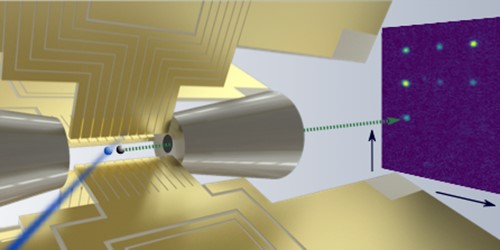Researchers can now place single ions into solids

Schematic representation of the ion trap (left) as the source of an ion beam to write a specific array of color centers into a crystal (right). Ill./©: QUANTUM, Institute of Physics, JGU
Modern electronics is based on doped semiconductors. To synthesize electronic components, dopant atoms such as aluminum or phosphorus are embedded into crystals of ultrapure silicon. This allows for tailoring semiconductor conductivity according to the desired application.
In modern electronic computer processors, miniaturized to just a few nanometers, only less than ten dopant atoms are relevant for the functionality. Quantum components, which are used for novel quantum computers or quantum simulators, will go even one step further in that they require an array with only single dopant atoms in a high-purity crystal.
Physicists at Johannes Gutenberg University Mainz (JGU) led by Professor Ferdinand Schmidt-Kaler now have developed a method to implant precise numbers of individual dopant ions into a solid crystal. Their technique implants the rare earth element praseodymium into an yttrium-aluminum garnet crystal.
These crystals were subsequently examined under a high-resolution confocal microscope in collaboration with a team of researchers headed by Professor Jörg Wrachtrup at the University of Stuttgart. They determined a positioning accuracy of 35 nanometers. In principle, this accuracy is already sufficient to implant arrays of dopant ions into components for future quantum processors.
The research results were published as a highlight in the current volume of the international journal Physical Review Letters and represent an important innovation with a wide potential for applications, as the method can be extended to other crystals and dopant atoms.
Image:
http://www.uni-mainz.de/bilder_presse/08_physik_quantum_dotieratome.jpg
Schematic representation of the ion trap (left) as the source of an ion beam to write a specific array of color centers into a crystal (right).
Ill./©: QUANTUM, Institute of Physics, JGU
Related links:
https://physics.aps.org/synopsis-for/10.1103/PhysRevLett.123.106802 – Synopsis “Placing Single Impurities into a Crystal” in Physics
https://www.quantenbit.physik.uni-mainz.de/ – Quantenbit group at the JGU Institute of Physics
Read more:
https://www.uni-mainz.de/presse/20212_ENG_HTML.php – press release “Physicists build the world's smallest heat engine” (15 April 2016)
https://www.uni-mainz.de/presse/17045_ENG_HTML.php – press release “Physicists at Mainz University build prototype of a single-ion heat engine” (3 Feb. 2014)
Professor Dr. Ferdinand Schmidt-Kaler
Quantum, Atomic, and Neutron Physics (QUANTUM)
Institute of Physics
Johannes Gutenberg University Mainz
55099 Mainz, GERMANY
phone +49 6131 39-26234
e-mail: fsk@uni-mainz.de
https://www.quantenbit.physik.uni-mainz.de/fsk/
K. Groot-Berning et al., Deterministic Single-Ion Implantation of Rare-Earth Ions for Nanometer-Resolution Color-Center Generation, Physical Review Letters 123, 4 September 2019,
DOI:10.1103/PhysRevLett.123.106802
https://doi.org/10.1103/PhysRevLett.123.106802
Media Contact
All latest news from the category: Information Technology
Here you can find a summary of innovations in the fields of information and data processing and up-to-date developments on IT equipment and hardware.
This area covers topics such as IT services, IT architectures, IT management and telecommunications.
Newest articles

NASA: Mystery of life’s handedness deepens
The mystery of why life uses molecules with specific orientations has deepened with a NASA-funded discovery that RNA — a key molecule thought to have potentially held the instructions for…

What are the effects of historic lithium mining on water quality?
Study reveals low levels of common contaminants but high levels of other elements in waters associated with an abandoned lithium mine. Lithium ore and mining waste from a historic lithium…

Quantum-inspired design boosts efficiency of heat-to-electricity conversion
Rice engineers take unconventional route to improving thermophotovoltaic systems. Researchers at Rice University have found a new way to improve a key element of thermophotovoltaic (TPV) systems, which convert heat…



